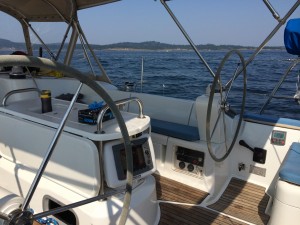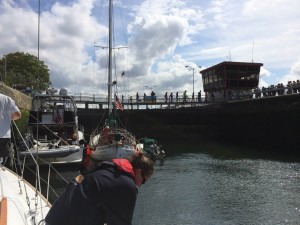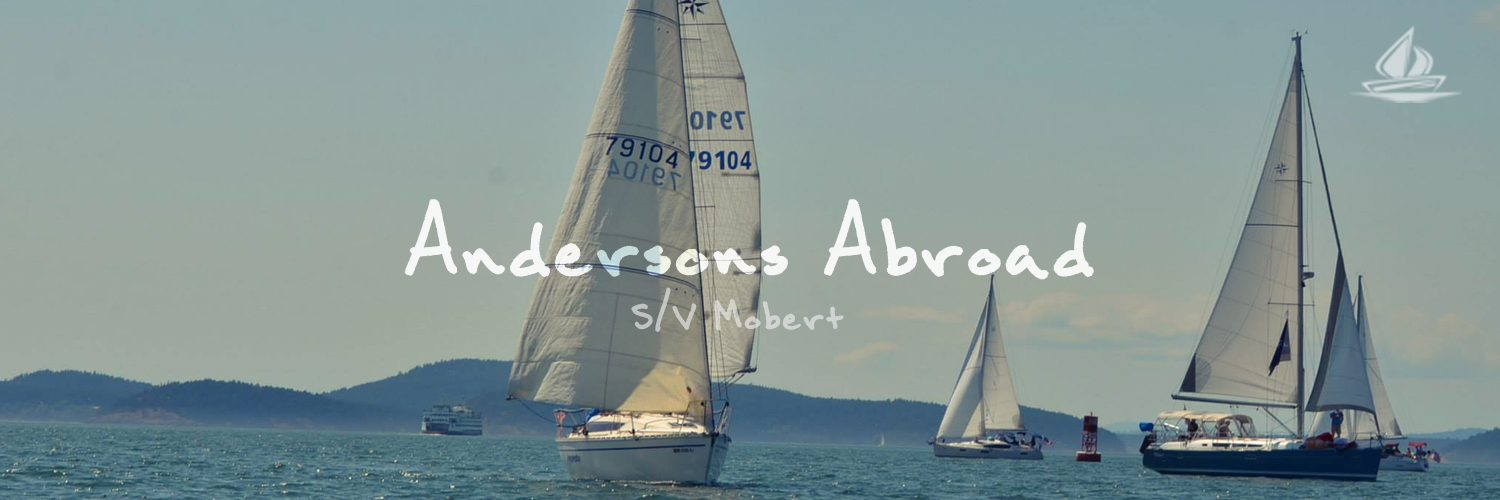August 2014 Sailing – First cruise in Mobert Part 5
Friday morning, when we woke up at Friday Harbor, we set out for breakfast at Blue Water Bar and Grill before heading out. Friday night marks our last evening in the San Juan Archipelago after which we start heading south toward home. It was sprinkling a bit of rain in the morning so we broke out the rest of the cockpit canvas and zipped it all up. One of the nice things the previous owner did was install a full cockpit enclosure and once it’s closed up,

it’s warm and dry in the cockpit. With a tiny bit of sun making it through the rain clouds the cockpit warmed up nicely. Plus the girls could play in the cockpit without worrying too much about life jackets.
We motored out way around the north side of Lopez and headed past Swifts Bay to Spencer Spit State Park. We grabbed a mooring buoy again and dropped our crap pot a couple hundred feet away. Then we took the girls ashore to the beach and played for a while. It was warm, mostly sunny, and the water was not nearly as cold as it should have been. The girls spent a lot of time wading in the water and playing in the sand. It was awesome!
Later we went back to the boat for sundowners and dinner. We also pulled up the crab pot to find 5 nice Dungeness crab inside. Unfortunately the only one we could probably have kept swam away through the door near the surface and the rest were too small or female. Another beautiful night at anchor. No problems with the genset, and still no issues with the manual toilets.
In the morning, we let the crab pots soak for a bit and ended up with another 5 Dungeness crabs we couldn’t keep. Then fired up to head out toward Deception Pass. We overestimated the time it would take to get there and ended up having to slow down and wait outside the pass for a bit. Not that big of a deal really. For a while we couldn’t decide whether we wanted to stop at Coupeville, Langley, or Everett for the night. Coupleville is super cool but we’ve been there a couple of times, and we wanted to get further south so our final run home would be shorter the next day. So we planned on Langley which sounded sort of cool.
Once we got to Langley however we found that the docks were full and the area where other boats were anchored seemed to be crowded enough and shallow enough that we weren’t comfortable. The tides were expected to drop 7 feet or so and we just didn’t have enough comfortable depth throughout our swing circle to stay. So we moved on to Port of Everett Marina which is where we used to keep our old boat. The advantage of Everett was also that we could refuel and after the long run we could grab a good dinner at Anthony’s Woodfire in the marina.
Sunday morning we got underway early, fueling up at Everett’s fuel dock first and then made our way toward Shilshole and the Ballard Locks. We believe the boat came to us with both tanks at about 7/8th full which is something like 90 gallons of diesel. Since taking delivery in June we’ve been motoring in and out of our slip in Kirkland, cruising up and down the lake, running the genset at anchor in the lake to run AC and watch football. Combined with the windless days on our trip, the daily genset usage, and the not quite full starting point of the tank, we calculated that we consume well under 1 gallon per hour of diesel on average. I also managed to finally calculate what our water meter is showing for our fresh water usage.

I originally thought that the water meter was showing gallons, but quickly realized that was foolish since it’s a French boat and even some of the switches are still in French despite being a boat sold for the US market. So I figured it was showing our consumption in liters. For a while it all seemed right, but then when the counter showed consumption more than what the tank actually holds I’d worry and fill the tanks. I finally let the large (aft) tank run empty and did the math (hmm. counter value is 8.1 per US gallon, what the heck value equals 1/8th of a gallon?) Well that makes me feel better because it means we aren’t consuming as much water as I feared. Incidentally I later let the smaller (forward) tank run empty and came up with nearly the same multiplication factor. Well now we know how to calculate our water consumption at least.
As we got closer to Shilshole the area was brimming with recreational fishing boats. I guess it was prime fishing season, and Labor Day weekend, AND a

Sunday morning, so it made sense. But we had to maneuver through all the boats and their lines to ensure we didn’t get a prop caught in something. The wait at the Ballard Locks was longer this time. First, the train bridge was down due to train traffic, and we had to wait a while for it to clear and go up. The bridge normally stays up since there’s more boat traffic than train traffic. Then once we got through the train bridge we had to wait for the locks for a while. Just as we were missing another east bound lock, they opened the large lock and we jumped right in.
In the picture here you can probably see the old wooden canoe style sailboat in front of us. This guy seemed to be single handing and likely knows what he’s doing pretty well. However he also seems to be the type of guy that thinks he knows more than others.. Let me explain…
In the small lock, the walls slide up and down and its way narrower so the boats don’t move too much and there’s little risk of major errors. In the large lock however it’s very wide, and when the doors open there is a large current. You can fit about 5 large boats across, and they tend to stack boats across to make it more efficient, but there’s no support lines going to the other side of the lock so stabilize your boat. As you enter, the Army Corps of Engineers that manage the locks give you instructions on what to do, where to tie, and in what ORDER to tie and untie your lines. Me? I figure they do this all day, every day, and I don’t, so they probably know more about it than I do. Mr. Singlehand wooden Canoe Boat, on the other hand, is apparently a lock transiting pro! Except he’s not.
After the water has finished rising and the east doors open, a strong current comes in and all the boats sway forward and back, then sort of settle down. The lock engineers instruct each boat on what to do and NO LESS THAN 20 times I hear “untie the bow line LAST”. They tell Mr. Canoe Boat the same thing and he asks to do the bow line FIRST anyway. They reiterate that he needs to untie the bow last, so he asks if he can just loosen the bow line a bit to prevent hull scratching, so they say okay, but DO NOT untie it. So 10 seconds later, he walks to the bow and unties the bow line. Seriously!? And then the $%^# hits the fan. His bow veers to starboard as the current pushes on it and swings his boat perpendicular to the lock. It’s looking like this beautiful, pristine, wooden boat is going to smash right into the wall or closed doors of the locks. He manages to untie the stern line steer hard left and floor the engine, which saves it. But it was so ugly for a moment. The joke for all the rest of the skippers leaving the lock was “I wonder if I should untie the bow line first or last?” Yeah, “last” is the right answer. Always listen to the lock attendants.. and apparently giving them cookies is recommended.

After that, we meandered through the 4 bridges and Lake Union and back into Lake Washington. The trip was over, the boat was unpacked, and we were home, with one more full day of weekend before heading back to work. All in all a great trip!



